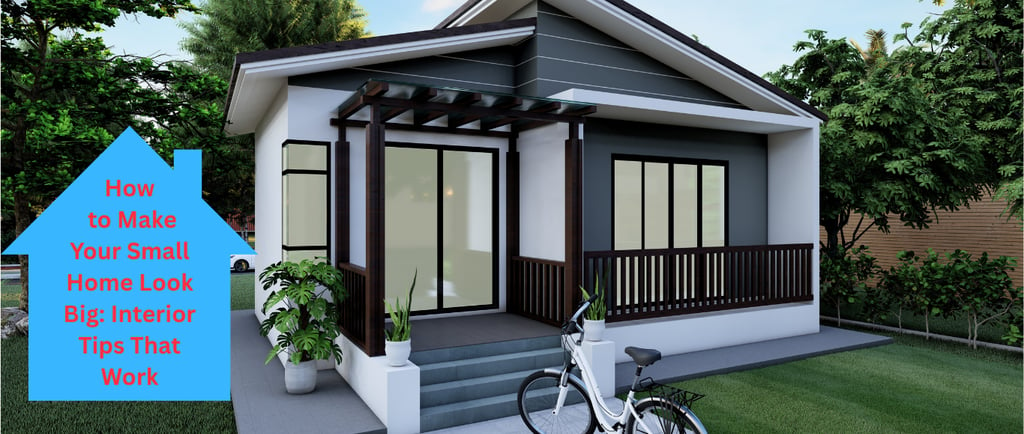How to Make Your Small Home Look Big: Interior Tips That Work
Living in a small home doesn’t mean you have to feel cramped or cluttered. With a few smart interior design tricks, you can transform even the tiniest space into a cozy, functional, and visually spacious sanctuary. Whether you’re in a compact apartment, a studio flat, or a small villa, the way you design your interiors can make all the difference.
flixah developers
8/4/20254 min read


How to Make Your Small Home Look Big: Interior Tips That Work
Living in a small home doesn’t mean you have to feel cramped or cluttered. With a few smart interior design tricks, you can transform even the tiniest space into a cozy, functional, and visually spacious sanctuary. Whether you’re in a compact apartment, a studio flat, or a small villa, the way you design your interiors can make all the difference.
In this blog, we’ll share practical and effective tips to make your small home look and feel bigger—without breaking the bank.
1. Choose Light Colors for Walls and Ceilings
Color plays a huge role in how we perceive space. Light colors reflect natural light, making a room feel open and airy, whereas dark shades absorb light and can make a space feel smaller.
What Works:
Use shades like white, cream, beige, soft grey, or pastels on walls.
Paint the ceiling white to create the illusion of height.
Use a monochromatic color scheme to maintain flow and continuity.
Pro Tip: Use the same color for the walls and curtains to avoid visual breaks.
2. Embrace Mirrors to Create Depth
Mirrors are one of the most powerful tools in small-space design. They reflect light, open up sight lines, and give the illusion of more square footage.
How to Use:
Place a large mirror opposite a window to reflect light and greenery.
Use mirrored furniture or panels to bounce light around the room.
Consider mirror wall art as both decoration and functionality.
3. Use Multi-Functional Furniture
When space is limited, your furniture needs to work smarter, not harder. Opt for pieces that serve more than one purpose.
Ideas to Try:
A sofa-cum-bed or ottoman with storage
Folding dining tables or nested tables
Beds with drawers or under-bed storage bins
Pro Tip: Look for furniture with slim legs or see-through frames to reduce visual weight.
4. Declutter and Use Minimal Décor
Clutter can shrink any room visually. The more items you have lying around, the more cramped your space will feel. Embrace a minimalist approach to make your small home look big and organized.
Tips:
Get rid of unnecessary furniture and décor items.
Use closed storage to hide clutter.
Keep surfaces like countertops and coffee tables mostly clear.
“Less is more” is truly the golden rule in small homes.
5. Let Natural Light In
Natural light has a magical way of making a room feel bright, fresh, and spacious. Avoid blocking windows with heavy curtains or large furniture.
Design Suggestions:
Use sheer or light-colored curtains that let sunlight filter through.
Keep window areas clear to allow maximum light.
If privacy is a concern, opt for frosted films or light blinds.
Pro Tip: If natural light is limited, use LED white lighting to brighten the room artificially.
6. Create Vertical Storage
When you can’t go wide, go tall. Utilizing vertical space helps reduce floor clutter and adds storage without taking up valuable walking area.
How to Use:
Install wall-mounted shelves or hanging cabinets.
Use tall bookshelves instead of short, bulky ones.
Hang storage racks in kitchens and bathrooms.
Bonus Tip: Paint shelves the same color as the walls to help them blend in and reduce visual bulk.
7. Keep Flooring Consistent
Different flooring in each room can create a chopped-up look. Uniform flooring gives a feeling of continuity, making the entire house feel larger.
Flooring Choices That Work:
Light-toned wooden flooring
Large tiles with minimal grout lines
Neutral vinyl flooring
Rugs are fine, but avoid using too many small ones—opt for one large area rug instead.
8. Use Glass and Lucite Furniture
Transparent materials such as glass, acrylic, or lucite are excellent for small spaces because they don’t block the view. These materials give the illusion of more open space.
Try These:
Glass coffee tables
Acrylic dining chairs
Glass shelves or TV units
These pieces virtually “disappear” into the room, helping the area look open and less crowded.
9. Incorporate Smart Lighting
The right lighting can change the feel of a room instantly. Use layered lighting to add depth and highlight different corners of your home.
Ideas:
Recessed lighting for a clean ceiling look
Wall sconces to free up floor space
Pendant lights to draw the eye upward
Use strip lights inside cabinets or under shelves
Avoid large floor lamps or over-sized chandeliers that can overwhelm small rooms.
10. Use Open Spaces Wisely
Avoid blocking pathways or doorways with furniture. Open spaces, even if small, give a sense of breathing room.
How to Optimize:
Float furniture away from the walls where possible.
Leave negative space (empty areas) to create balance.
Keep walkways clear and wide enough for comfortable movement.
Arrange furniture to maintain flow and openness—even in the smallest room.
11. Add Vertical Lines and Patterns
Just like in fashion, vertical lines elongate the appearance of a room. They draw the eye upward and give a sense of height.
Apply This With:
Vertical stripes on wallpaper
Tall bookshelves or art pieces
Long curtains that start from the ceiling
Avoid overly busy patterns or oversized prints that may dominate the space visually.
12. Choose Compact Appliances
In kitchens and bathrooms, consider using compact or built-in appliances that blend with cabinetry. Wall-mounted or under-counter units save space and reduce clutter.
Look for:
Slim refrigerators
Wall-mounted microwaves
Stackable washers and dryers
These give you full functionality without taking up precious square footage.
Final Thoughts
A small home doesn’t have to feel small. With the right design choices—light colors, reflective surfaces, smart furniture, and vertical space—you can create a spacious, stylish, and functional living area that feels like a breath of fresh air.
Design is not about square footage—it’s about smart usage of space. Whether you’re living in a studio apartment or a compact house, these interior tips will help your home feel bigger, brighter, and more welcoming.
Remember: It's not about how much space you have, but how creatively you use it.
for more info on real estate investment you can visit our website flixahdeveloperspvtltd.com or you can also reach us @ +91 9100600730
